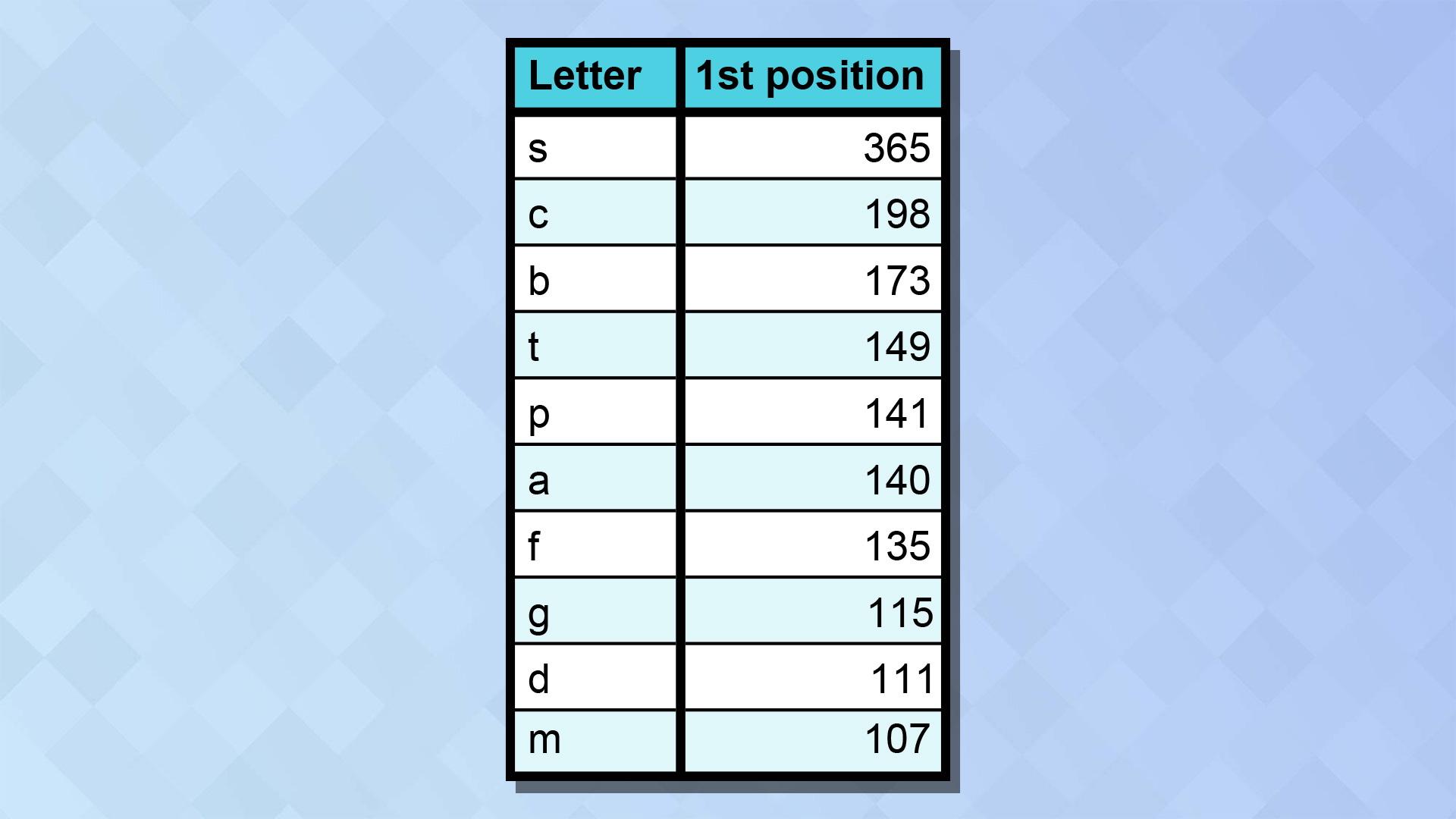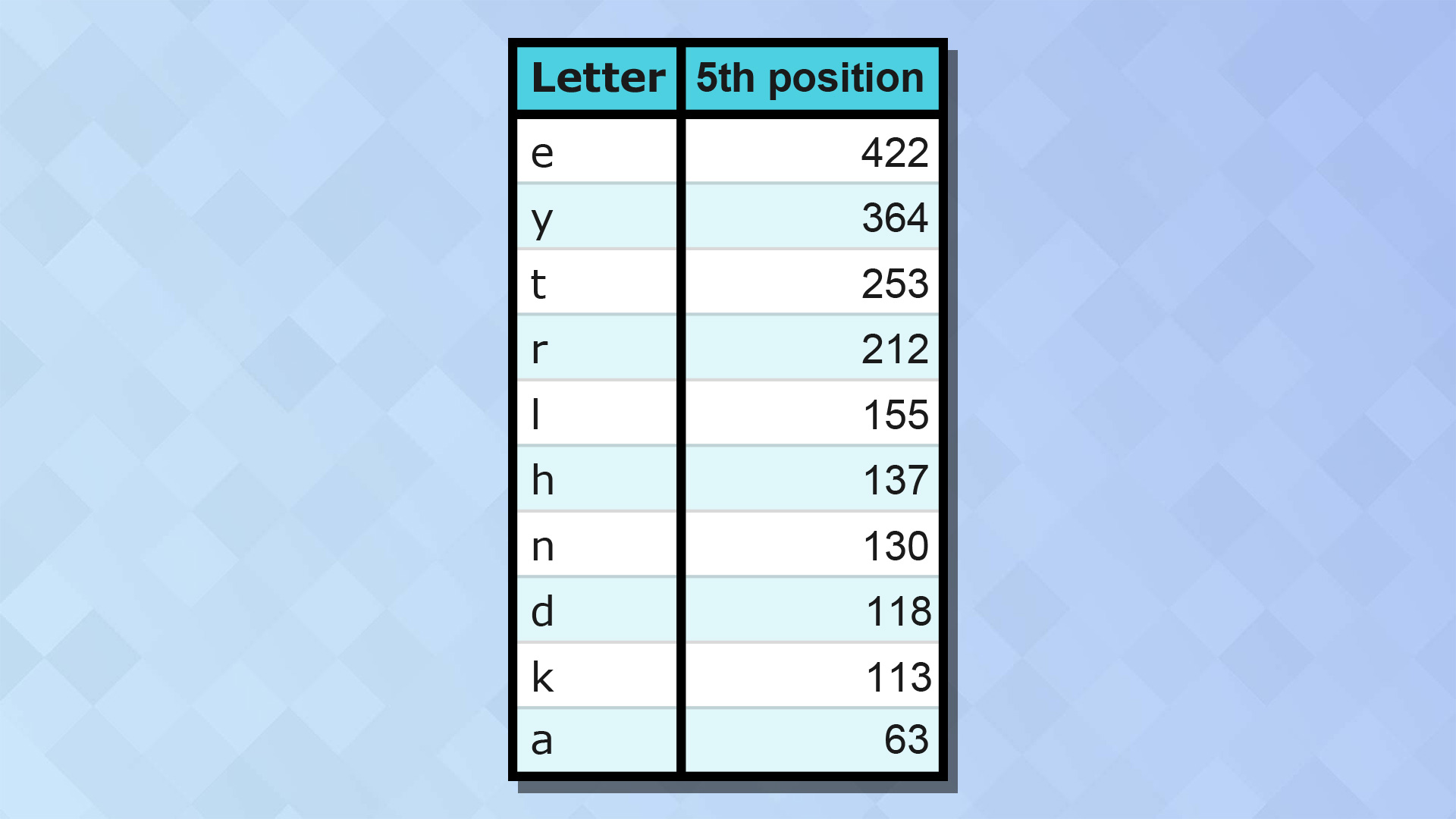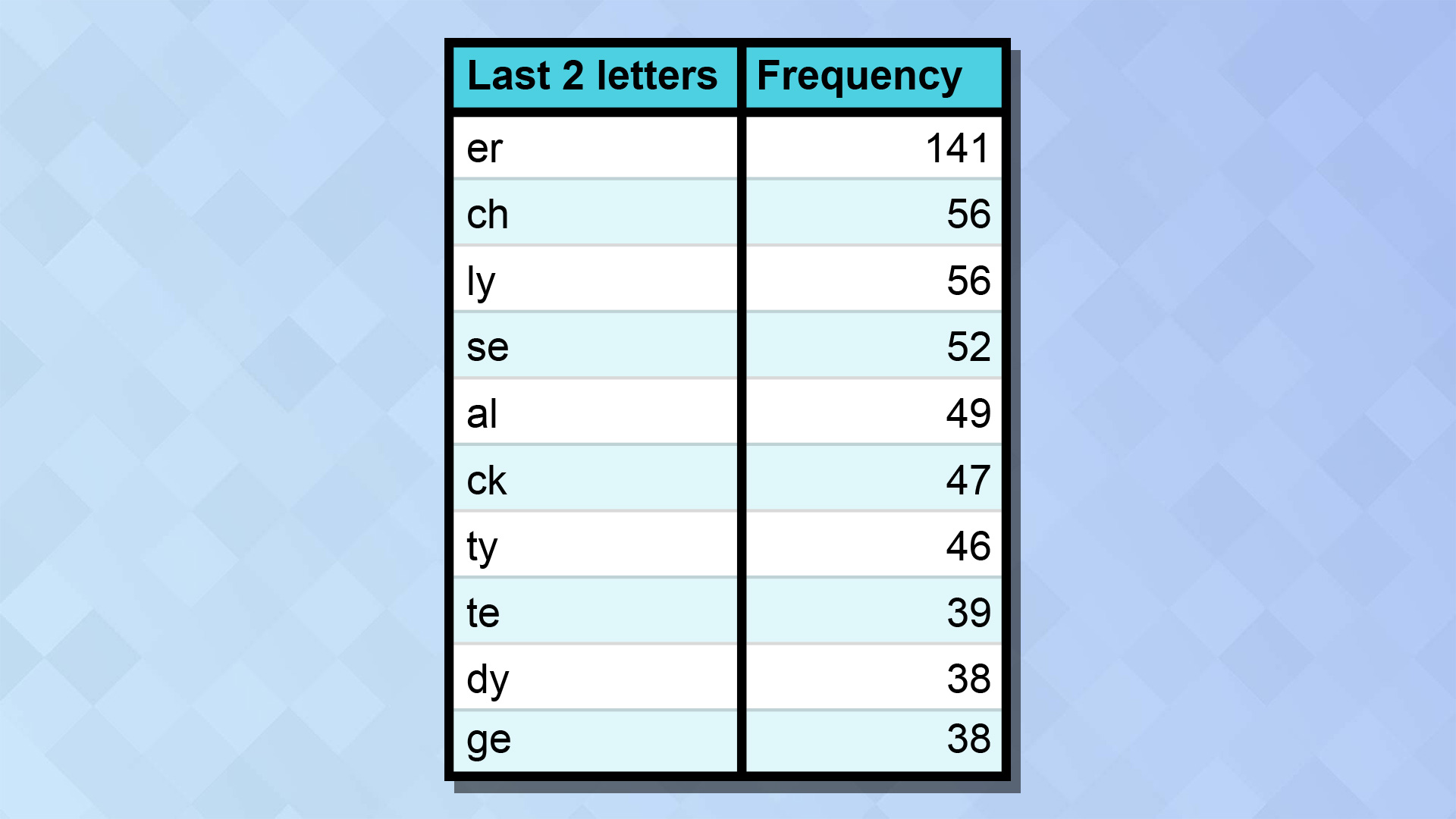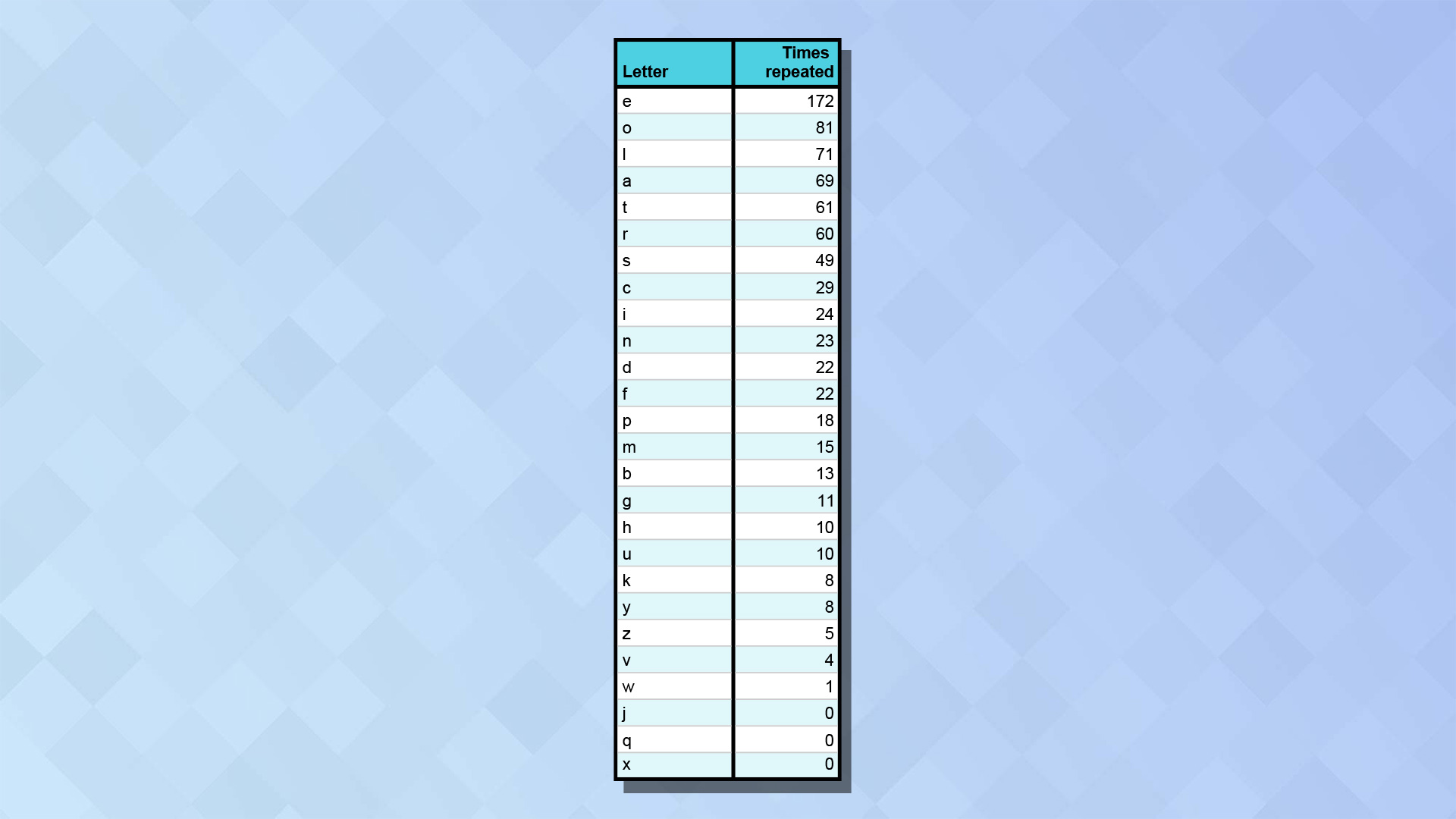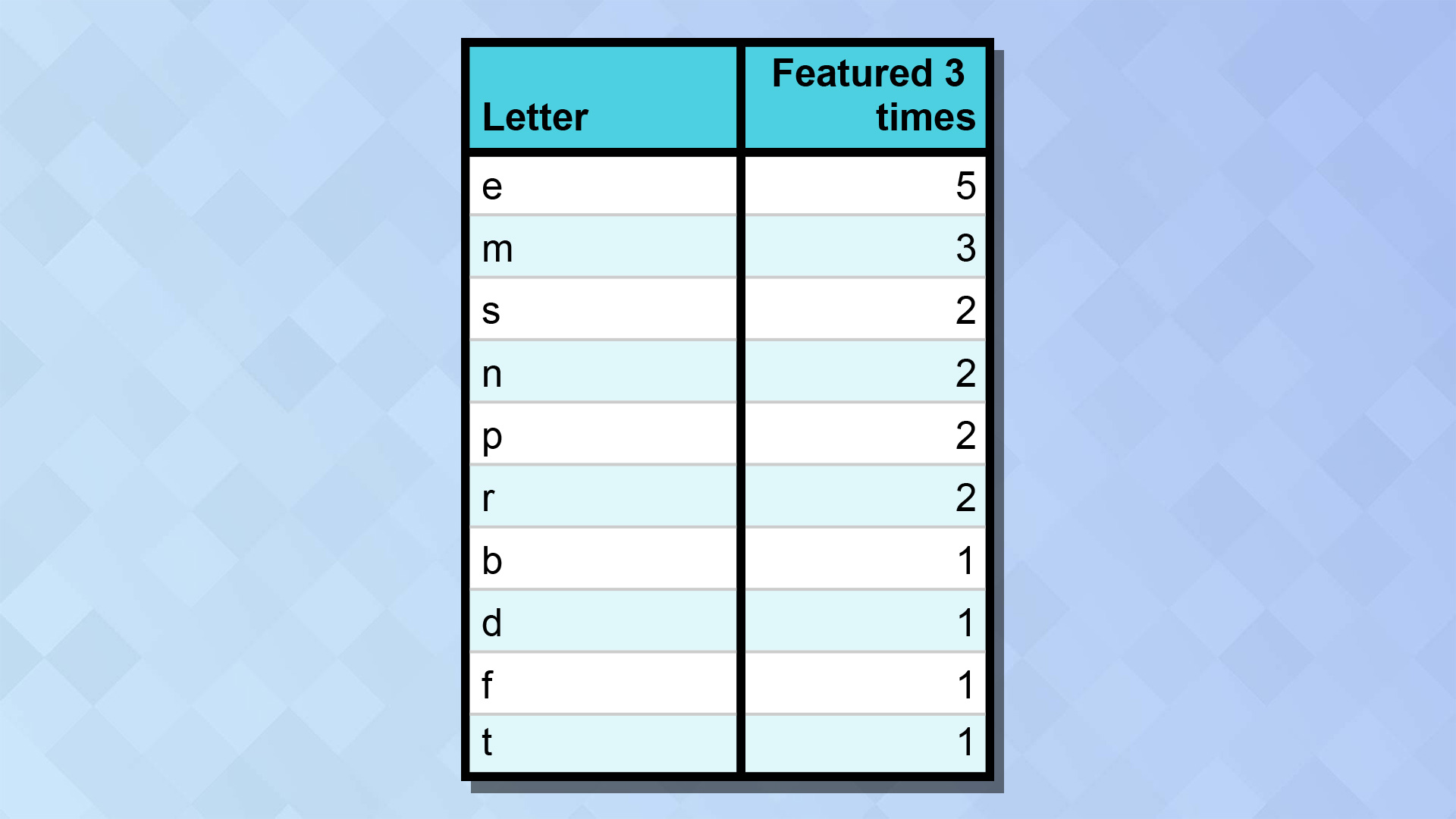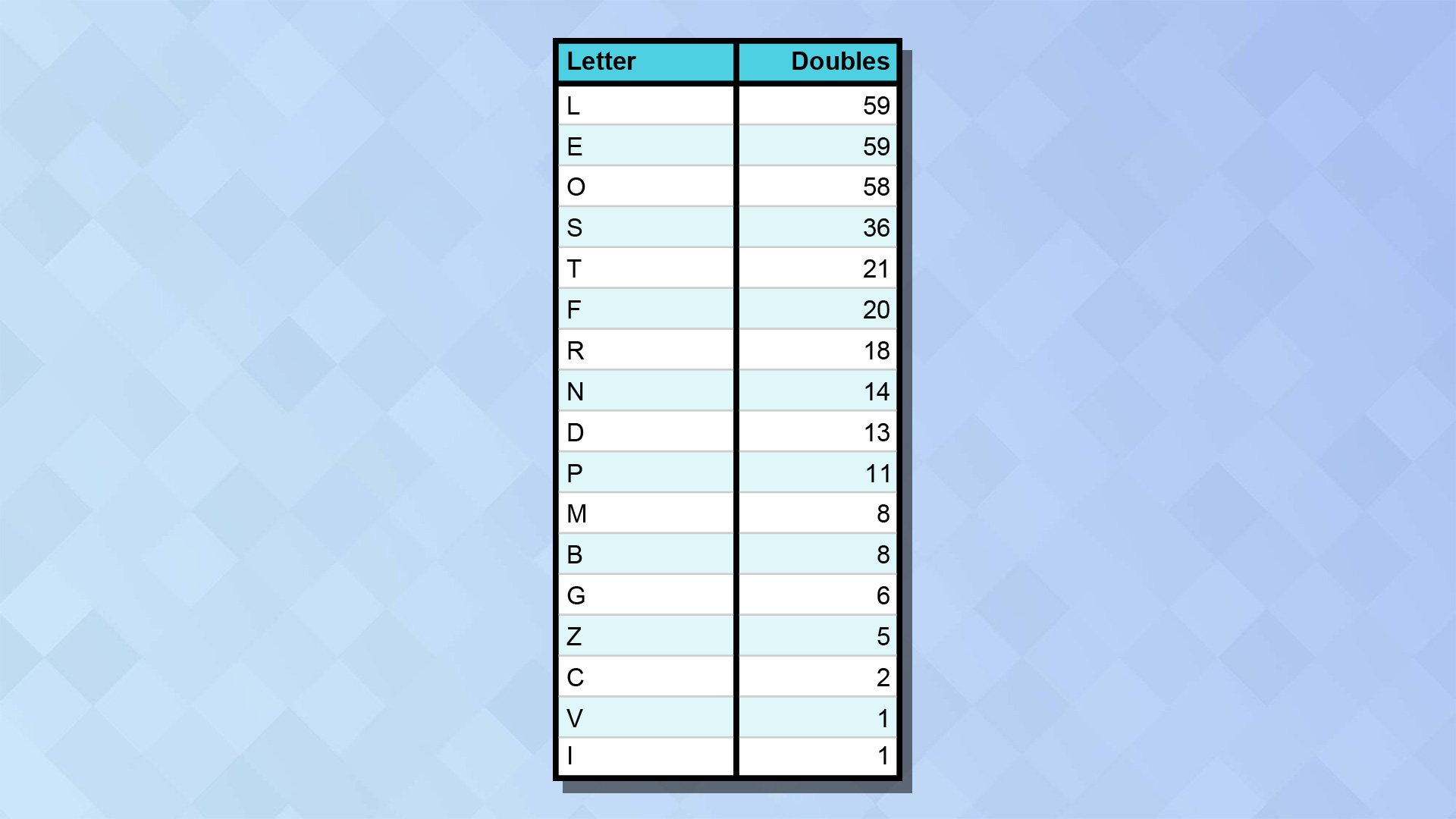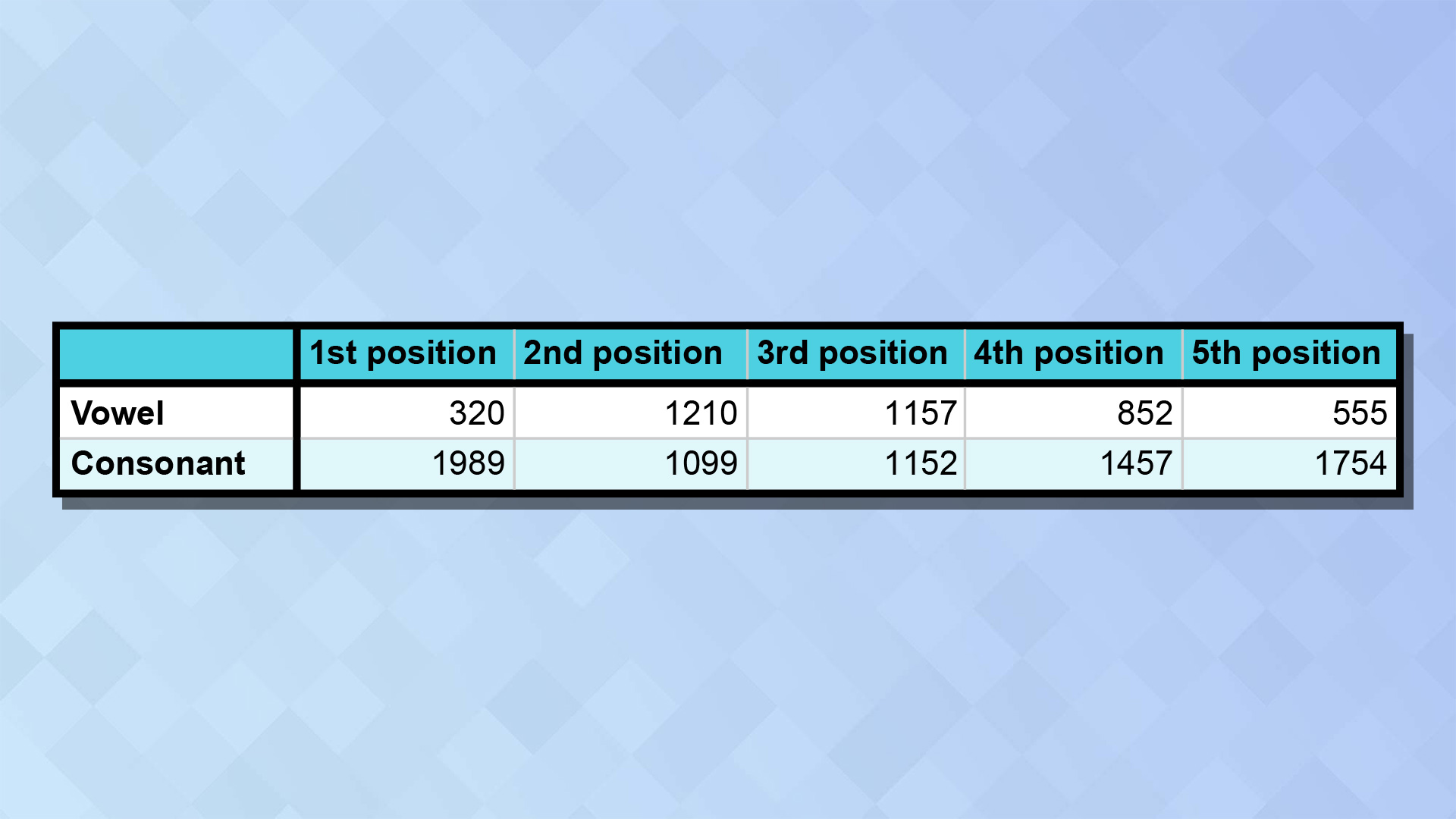I analyzed every Wordle answer to look for patterns — here's what I found
Wordle is a game about words, but numbers can help you beat it

Though Wordle is a game about words, numbers can also help you beat it — and it’s all down to probability.
Every answer is one of 2,309 possible solutions. And every letter has a probability of featuring in any particular position. Knowing these probabilities and adjusting your strategy accordingly can help you beat the game and safeguard your streak.
The good news is that anyone can crunch the data by downloading the New York Times’ list of Wordle answers. And the other good news is that I'm a proper Wordle geek, so I've done it for you.
Is this cheating? Well maybe; that’s for you to decide. I prefer to think of it as the Moneyball approach to Wordle, in that it’s merely using the available data to gain an advantage and avoid the need to search for today's Wordle hint. And don't worry, I won't spoil any solutions that haven't already been in the game.
So read on for some seriously useful information about everything from the most common starting and ending combinations to the likelihood of there being three consonants in a row or the chance of getting a double V (0.04% since you ask).
For a slightly different take, we've also analyzed every Wordle answer used so far, so you can see the trends we've spotted among the words that have been used.
Wordle by numbers: The basics

Most common letters
I cover this ground in my best Wordle start words article, but let’s dig a little deeper here. Wordle is not identical to the English language when it comes to letter frequency. There are obvious similarities, but the reduced word pool does have an effect.
Get instant access to breaking news, the hottest reviews, great deals and helpful tips.
E is the most common letter in both English and Wordle answers, but almost every other letter is either more or less frequently used in Wordle. T, for instance, is the second most common letter in English, but only fifth in Wordle. N and I are also less common in Wordle.
The biggest differences are with R, H, L, F and Y. For instance, Y is way more common in Wordle than in English in general, and H a lot less common.
That’s definitely affected my own strategy; until recently I would rarely play a Y early in the game, but I now use it more often than letters such as D and M.
Most common letters by position
Knowing the most common letters in Wordle is one thing, but knowing where they are most common is more helpful still. As such, this is my favorite Wordle data table — and yes, I really need to get out more.
To return to Y again, I said above that it's more common in Wordle than in English in general — but that's only true when it's at the end of the word. Elsewhere, it's hardly used at all.
Or take E — it’s the most frequently used letter among Wordle answers by far, but it's another that only appears regularly at the end of a word. There are several more common letters in first, second and third positions, to the extent that even W, the sixth least common letter overall, is more likely to start a Wordle answer.
Conversely, K ends 113 Wordle answers but is only used in the other four places a combined 97 times. S, meanwhile, starts more than half of the Wordle answers it features in.
Most common starting and ending letters
This comes out of the above, obviously, but it’s worth breaking out these two vital elements of a Wordle answer. Get these right and you’ll be well on the way to finding the answer.
Here are the 10 most common Wordle starting letters:
And the 10 most common ending letters:
Wordle by numbers: Intermediate

Most common starting combinations
Knowing the most common starting letters is helpful, but the same two letters often go together, so having an idea of what the most frequent starting combinations are is potentially even more useful.
There are 214 distinct two-letter starting combos among the 2,309 Wordle answers, so too many to list here. But many only occur a handful of times; in fact, about half of them feature in fewer than five answers. So let’s just look at the really common ones:
It’s not that surprising that S and C feature in the first five, given they are the two most common starting letters. But GR in sixth? FL in seventh? That did surprise me.
So, what about ending combos? There are 203 distinct endings, and as you’d expect, ER is the most common by some distance. But there are a few high up that list that you wouldn’t necessarily expect, such as SE (TEASE, game 269) and TY (NASTY, game 256).
It’s definitely worth memorizing those starting and ending combinations, and bearing them in mind when attempting to solve the puzzle.
However, it’s important to remember that lots of them are only used once or twice — so watch out for WD, IK or XT, coming to a Wordle answer near you soon.
Wordle by numbers: Expert

Repeated letters
Repeated letters regularly cause people problems in Wordle. Nobody likes to play one, because it feels like a waste of a guess. But repeated letters are actually pretty common in the game.
In total, 748 of the 2,309 Wordle answers contain a repeated letter: that’s about 15%, so you’d expect to get one every week on average.
E is the most common repeated letter, with two Es featuring in 172 answers. O is next (81), then L (71), A (69), T (61) and R (60). Even Z is repeated in 5 games; only J, Q and X are never repeated.
But there’s more than just repeated letters to think about: 38 of those 748 games have two sets of double letters. We’ve not had one recently, but game 54 (BOOBY) was one, and it very nearly caught me out. More will undoubtedly follow.
There are also a further 20 games that use the same letter three times: we had one in game 71, with ERROR. There’s even one game with one triple letter and one double. I look forward to Twitter on that day. Only 10 letters get the triple treatment, with E the most common of them.
A further subset of repeated letters is double letters, where you get two together. In some ways these are easier to spot — or at least they are when it comes to the likes of L and S. Further down the list are some letters that you really don’t expect to see sat next to each other. Double C or V, anyone?
Vowels vs consonants
Many people play all the vowels as soon as possible, because almost all Wordle answers feature at least one vowel. I say most, because 12 out of the 2,309 solutions don’t have a vowel in them.
I should say at this point that by vowel I’m specifically referring to A, E, I, O and U. Some people count Y and even W as vowels, depending on how they’re used, and indeed those 12 vowel-less words all use a Y in place of the traditional options. We had one very recently, in game 281: NYMPH.
Vowels are very common in Wordle words, then — but they’re not quite as common as consonants. Across Wordle’s 2,309 answers there are 11,545 letters used and of these 4,094 are vowels compared to 7,451 consonants — so 35% to 65%. In short, you’d expect just under two vowels for every three-and-a-bit consonants.
That doesn’t tell you a lot, but what is helpful is knowing where they are most common. Look at the table below and the pattern jumps out right away: vowels are nowhere near as common at the start or end of words, but are actually more common in the second and third places.
Of course it does vary wildly by specific vowel. As we saw earlier, E is actually the most common letter in both fourth and fifth position; so just don’t start with a vowel too often.
Two vowels together are also fairly common, and not always where you might think. A total of 23 Wordle answers start with two vowels (think AUDIT, game 91) and 257 have vowels in second and third places. 227 have them in positions three and four and 56 end with two vowels. Two words even start with two vowels and end with two.
Two consonants together are so common that I didn’t bother counting them, but what about three or four? Well, 18 Wordle answers have four consonants in a row, of which five come at the start of a word and 13 at the end.
For three in a row, most come at the end: 306 Wordle answers end with three consonants (remember WATCH?), but only 35 start with three and surprisingly only 12 have three in the middle with a vowel on either side.
I’m not sure how helpful this is, but it’s definitely worth remembering that three consonants in a row is really not that unusual.
So there you go: Wordle is just a matter of probability. Except of course that’s not really true, and it takes half of the fun out of it if you spend your whole time focused on this kind of data. Sometimes you just get a feel that an answer is right, and sometimes it even is. For instance, this really happened to me, back on my ninth ever go.
Wordle through 1,000 games
It's hard to believe, but there have now been more than 1,000 Wordles played, so we thought it would be a good time to see if there are any trends in this first batch, to see how they compared with all of the possible answers.
Most common letter by position
So this is a pretty big list, but we can see some trends emerging. E, the most common letter, has appeared 208 times in the fifth position (21% of the time) and 102 times in the fourth position (10% of the time). It will eventually appear 422 times in the fifth spot (18%) and 318 times in the fourth spot (13%), so expect to see it slightly less in the last spot and slightly more in the fourth spot.
S will eventually appear 365 times in the first position (16%); thus far, it's shown up 140 times (14%), so its frequency will increase a touch more.
A will take over both the second and third spots at 304 and 306, respectively, but through the first 1,000 games, O is edging it out in the second spot, with 135 appearances to A's 126. Interestingly, the frequency with which A has appeared in the second spot — about 13% of the time — is in line with its final tally. O has appeared 14% of the time, but that will eventually drop back to 12%.
Double letters
"EE" has been used the most, at 22 times, followed by "OO" at 20, "LL" at 19, and "SS" at 14. Given that there are 59 LLs and EEs in total, expect to see a greater frequency of them. There are a total of 58 EEs, so they should be popular too. There are a total of 21 TTs, but only six have shown up thus far.
Wordle through 1,200 games
A bit more shifting in frequency:
S has now shown up 179 times in the first position; it's going to appear 365 times in total, and with 1,109 games remaining, it should appear here 17% of the time from here on out.
In the second position, A has shown up so far 152 times, halfway on its way to 304. It'll appear here 14% in the remaining games.
Interestingly, A also is the most common letter in the third position (306 times in total), but has appeared here 182 times already, so it's destined to show up just 11% of the time here going forward.
In the fourth position is E, at 318 times total, but just 157 times to date. So it's going to show up here another 161 times, for a total of 15%.
E is also the most common letter in the fifth position. Once all games have been played, it will appear here an astounding 422 times. It's been used 245 times so far, dropping slightly to 20% from 21% after 1,000 games. That's to be expected, as its final percentage here will be 18%. So, it will show up 16% of the time here in the remaining games.
Wordle through 1500 games
As of July 28, 2025, Wordle passed the 1,500 mark (a particularly tricky "savvy'), and with that, the letter frequency has shifted, ever so slightly.
S: Has now appeared 228 times in the first position.
A: Still the most popular second letter (192 times), though O (187) and R (181) aren't far behind. A still dominates the third position, appearing here 231 times; the next closest is O, at 180.
E: Has shown up 196 times in the fourth position, well in front of N (124).
For the fifth letter, E has shown up an astounding 306 times. In second place is Y, at 205.
Here's how often the top 10 letters have appeared in any position:
E: 35.5%
L: 19.6%
A: 10%
S: 9.9%
Y: 8.9%
G: 8.7%
R: 7.8%
K: 5.8%
W: 5.4%
B: 5.1%
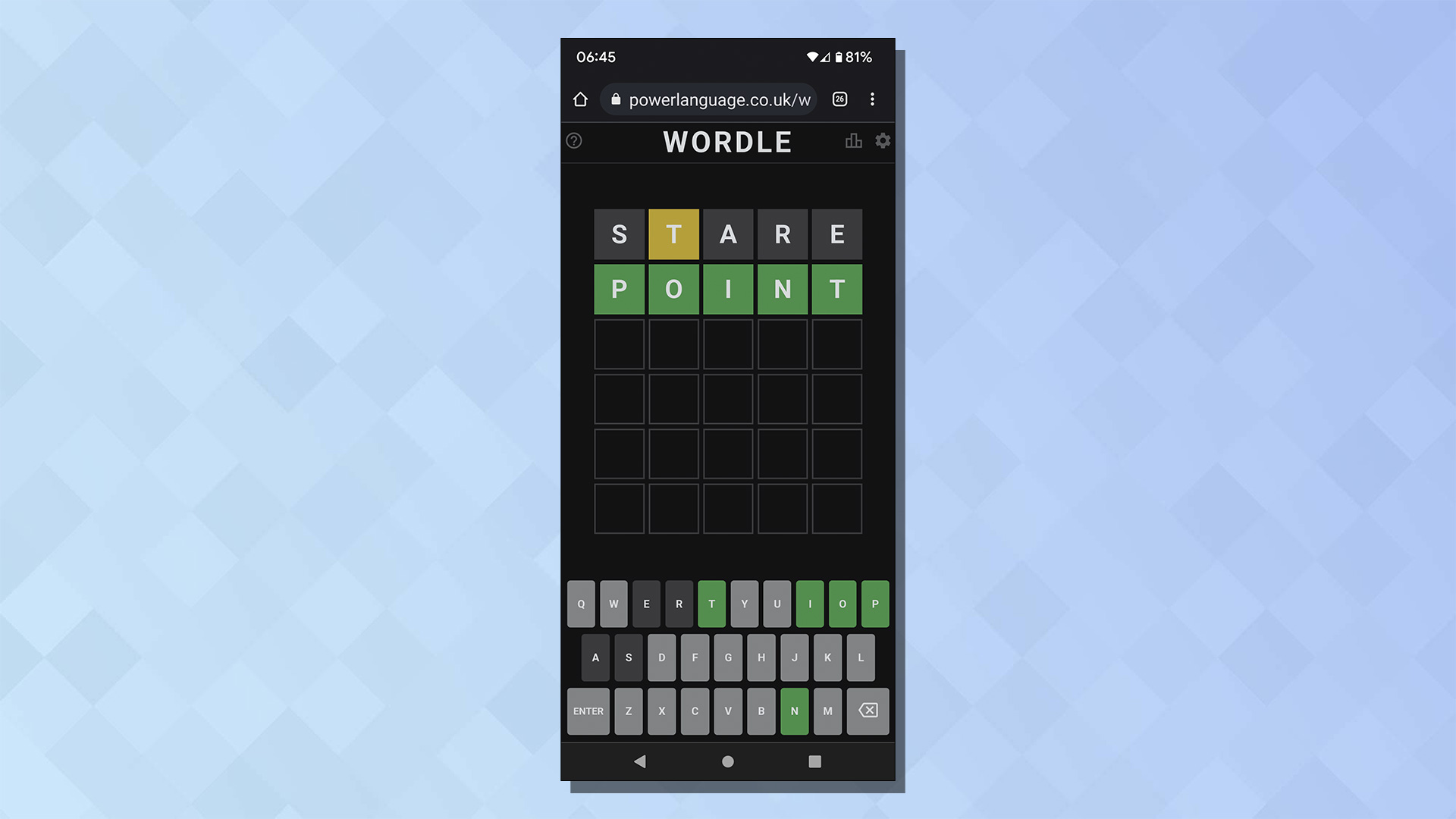
Data can be incredibly helpful for giving you a helping hand in Wordle, but you're always going to need a bit of luck — or the odd Wordle hint, too. And that's one of the things that makes it such a great game. Happy Wordling.

Formerly Editor in Chief (U.K.) on Tom’s Guide, Marc oversaw all gaming, streaming, audio, TV, entertainment, how-to and cameras coverage, and was also responsible for the site’s U.K.-focused output. He is now U.K. Editor in Chief on TechRadar. Marc previously edited the tech website Stuff and has tested and written about phones, tablets, wearables, streaming boxes, smart home devices, Bluetooth speakers, headphones, games, TVs, cameras and much more. He also spent years on a music magazine, where his duties mainly involved spoiling other people’s fun, and on a car magazine. An avid photographer, he likes nothing better than taking pictures of very small things (bugs, his daughters) or very big things (distant galaxies). When he gets time, he also enjoys gaming (console and mobile), cycling and attempting to watch as much sport as any human can. He's also fallen in love with Wordle over the past six months and is the author of our today's Wordle answer column, in which he supplies hints and strategy tips for the mega-popular word game. Given he's completed every single Wordle so far and only lost once, and analyzed every Wordle answer in search of patterns, he's well qualified to help you safeguard your streak.
- Mike ProsperoU.S. Editor-in-Chief, Tom's Guide
You must confirm your public display name before commenting
Please logout and then login again, you will then be prompted to enter your display name.
